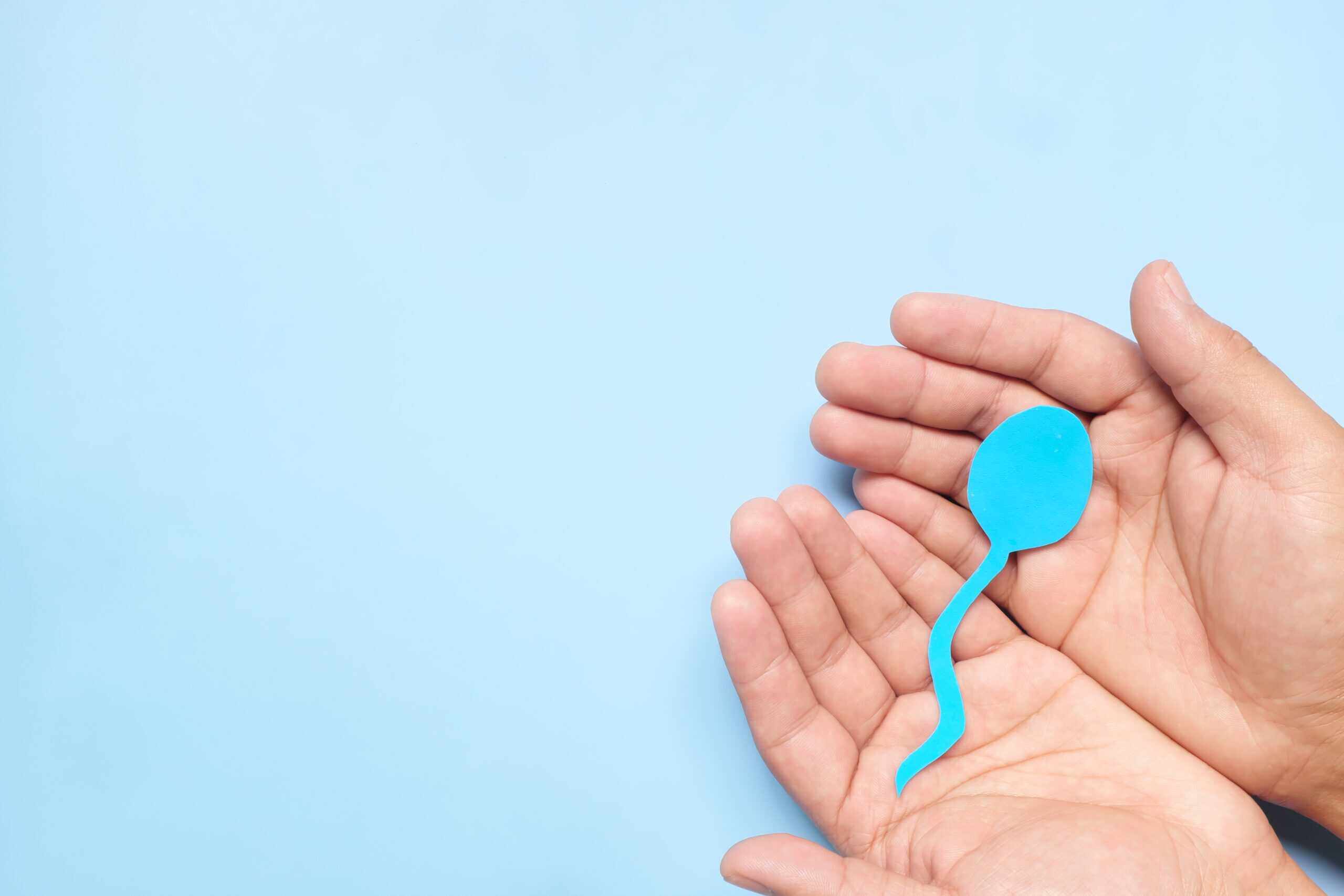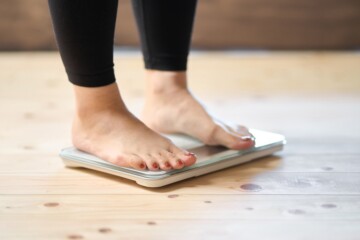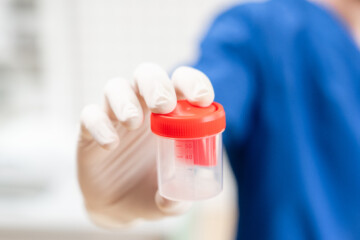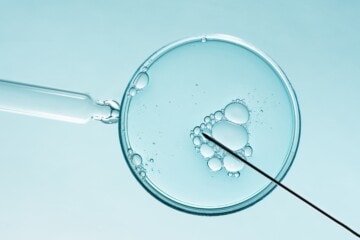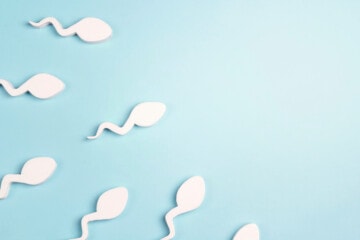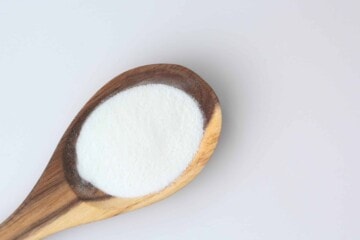Some factors which influence male fertility, such as genetics, illness or age, cannot be controlled. But fortunately, there are things you can do to improve your chances of conceiving. Read on as we shine a spotlight on everything you need to know about sperm morphology. We look at how abnormal sperm can make it more difficult to fertilise the woman’s egg but focus on what you can do to improve your sperm morphology and, therefore, your chances of successfully conceiving.
What is sperm morphology?
Sperm morphology refers to the size, structure and shape of your sperm. Sperm morphology will be investigated during a semen analysis. The semen is studied under a microscope — they’ll be looking for any signs of unhealthy sperm and the ratio of normal sperm to abnormal. Sperm morphology is calculated by a percentage of ‘normal forms’. Even a healthy, fertile man will have a large number of abnormal sperm within the semen sample — in fact, it’s typical for over half of the sperm to be abnormal.
What is the importance of sperm morphology?
Your sperm morphology is important as it affects the sperm’s capability to move effectively and reach and fertilise the egg. Those with abnormal sperm morphology might find it more difficult to conceive naturally, but it’s still possible. Even men with 0% normal forms can still get their partner pregnant. But sperm morphology is considered a critical factor to measure during a semen analysis as higher ranges of normal sperm morphology equate to more successful pregnancies.
What affects sperm morphology?
Age
Unfortunately, sperm morphology tends to decrease as you age. Many studies going back many years (1988, 1995, 1999) indicate declines in normal sperm morphology of 0.2% to 0.9% per year of age, resulting in a 4% to 18% decrease in normal morphology over a 20-year period.
Lifestyle
Sperm morphology can be affected by your lifestyle. Things like too much alcohol, smoking, excess weight, stress, lack of exercise and sleep, and a poor diet can all be detrimental to sperm morphology. Studies have found that physically active men have improved sperm morphology. And diets which are high in added sugars, fried foods and red meats have been linked to lower sperm morphology.
As with your general health, your fertility health will be improved if you quit smoking. More specifically, a 2019 review found a direct link between poor sperm morphology and smoking.
Toxin exposure
Multiple studies suggest environmental toxins have a negative impact on sperm morphology. Some men are exposed to toxins more than others, for example, those who work in plastic production handling chemicals, those in agriculture (working with pesticides) and those working with metal (like welding).
How to improve sperm morphology?
If you are wondering how to improve your sperm morphology (and how to boost male fertility in doing so) then take a look at the changes you can make:
Adopt a healthy diet
Try adding foods which are beneficial for male fertility into your daily diet. Take a look at our top foods to include in your male fertility diet, including:
✔ Nuts
✔ Leafy greens
✔ Lean meats
✔ Oily fish
Maintain a healthy weight
If you’re overweight, moderate exercise may help you to lose weight, along with a healthy eating plan — and this all helps to improve sperm morphology. Add regular exercise to your routine, things like walking, swimming and jogging.
Avoid exposure to toxins
Toxins are all around us. But there are ways to limit exposure. For example, exposure to phthalates BPA and microplastics (such as those in plastic bottles) can affect sperm morphology. You can choose BPA-free plastic food and drink containers and choose tap water over bottled water. You can avoid heating food in plastic containers. You can also reduce chemical exposure by washing fruit and veg before eating, avoiding processed foods when you can, and choosing natural cleaning products over potent cleaning products.
Manage stress
So many studies over the years have linked stress to infertility, including the impact of stress on sperm production. To manage your stress levels, incorporate stress-relieving activities into your daily routine. Things like meditation (there are various meditation apps which may help), yoga, spending time with animals and nature, going for walks or making sure that you include time for a hobby you enjoy.
Eating foods rich in antioxidants
Including antioxidants within your diet can also help improve sperm morphology (as well as sperm count and sperm motility). Antioxidants remove the reactive oxygen species (ROS) and prevent DNA damage in sperm. Examples of foods which are rich in antioxidants include green tea, berries and dark chocolate. Be careful: many supplements contain strong antioxidants, which can damage sperm by causing reductive stress. Conversely, Impryl contains exactly the right balance of micronutrients to enable the body to achieve the right balance for optimum sperm health.
If you’re told that your sperm morphology is abnormal after a medical investigation, there are so many positive changes that you can make that will make a difference. And along with lifestyle changes, Impryl will give both you and your partner the peace of mind that you are supporting your fertility from all angles, as it benefits both sperm and egg production.
References:
Andolz P, Bielsa MA, Vila J. Evolution of semen quality in North-eastern Spain: a study in 22,759 infertile men over a 36 year period. Hum Reprod. 1999;14:731–735.
Auger J, Kunstmann JM, Czyglik F, Jouannet P. Decline in semen quality among fertile men in Paris during the past 20 years. N Engl J Med. 1995;332:281–285.
Bundhun, Pravesh Kumar et al. Tobacco smoking and semen quality in infertile males: a systematic review and meta-analysis. BMC Public Health volume 19, Article number: 36 (2019)
Bujan L, Mieusset R, Mondinat C, et al. Sperm morphology in fertile men and its age related variation. Andrologia. 1988;20:121–128.
Harris, Isiah D et al. Fertility and the Aging Male. Rev Urol. 2011; 13(4): e184–e190.
Mima, Mahmoud et al. Environmental Toxins and Male Fertility. Curr Urol Rep. 2018 May 17;19(7):50. doi: 10.1007/s11934-018-0804-1.
Mínguez-Alarcón, Lidia et al. Effects of bisphenol A on male and couple reproductive health: A review. Fertil Steril. 2016 Sep 15; 106(4): 864–870.
Nassan, Feiby L et al. Association of Dietary Patterns With Testicular Function in Young Danish Men. JAMA Netw Open. 2020 Feb 5;3(2):e1921610. Doi: 10.1001/jamanetworkopen.2019.21610.
Vaamonde, Diana et al. Physically active men show better semen parameters and hormone values than sedentary men. Eur J Appl Physiol. 2012 Sep;112(9):3267-73. doi: 10.1007/s00421-011-2304-6. Epub 2012 Jan 11


